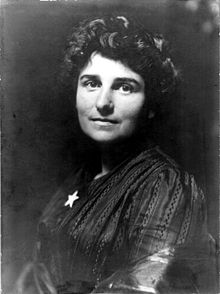Maud Ballington Booth

Maud Elizabeth Charlesworth (September 13, 1865 – August 26, 1948) later changed her name to Maud Ballington Booth, was a Salvation Army leader and co-founder of the Volunteers of America.[1]
She was born in Limpsfield, near Oxted, Surrey, England, the daughter of the local Anglican rector. One of three girls, she was a sister to bestselling romance novelist, Florence L. Barclay. When she was four, her father, Rev. Samuel Charlesworth, moved his family to Limehouse in London. The work of both her parents there in social issues led to Maud’s interest for social welfare and social service. In 1882, she became a companion of Miss Catherine Booth in organizing a branch of the Salvation Army in Paris. In 1883, they went to Geneva, Switzerland, where they were both expelled after aggressive police interrogation.[2] She stayed with the Booth family and worked in the London slums and elsewhere until her marriage to the second son of the founder of the Salvation Army, Ballington Booth in 1886, against her father's wishes.[3]
In 1896, Ballington and Maud left the Salvation Army after a dispute with General Booth, to co-found the Volunteers of America. Maud was also known for working to improve the conditions of prisons in the late 19th and early 20th centuries.[1] She later toured on the Chautauqua circuit, moving audiences with her vivid account of life in prisons and calls for reform. Her publications include:
- Branded (1897)
- Lights of Child-Land (1902)
- After Prison —What? (1903)[4]
- Twilight Fairy Tales (1906)
Among the other causes she embraced was the legalization of euthanasia.[5]
References
- ^ a b "Booth, Maud Ballington". Learningtogive.org. Retrieved July 1, 2005.
- ^ Geneva Correspondent (19 February 1883). "A Lamb Among Wolves". The Times.
{{cite news}}:|author=has generic name (help) - ^ Maud Ballington Booth (1994). A Rector's Daughter in Victorian England. Volunteers of America. ISBN 1-885-287-01-1.
- ^ Maud Ballington Booth (1903). After Prison - What?. Fleming H. Revell Company – via Project Gutenberg.
- ^ Appel, Jacob (2004). "A Duty to Kill? A Duty to Die? Rethinking the Euthanasia Controversy of 1906". Bulletin of the History of Medicine. 78 (3): 614. doi:10.1353/bhm.2004.0106. PMID 15356372.
External links
- Works by Maud Ballington Booth at Project Gutenberg
- Works by or about Maud Ballington Booth at the Internet Archive
- Maud Ballington Booth at Find a Grave
- Maud Charlesworth (Mrs. Ballington) Booth From a scrapbook in the Carrie Chapman Catt Collection in the Rare Book and Special Collection Division at the Library of Congress
- Maud Ballington Booth, photograph; to speak in Geneva From a scrapbook in the Carrie Chapman Catt Collection in the Rare Book and Special Collection Division at the Library of Congress
